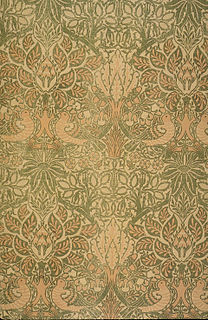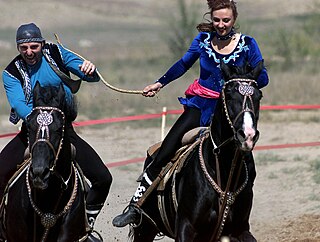Related Research Articles

A textile is a flexible material made by creating an interlocking bundle of yarns or threads, which are produced by spinning raw fibers into long and twisted lengths. Textiles are then formed by weaving, knitting, crocheting, knotting, tatting, felting, bonding, or braiding these yarns together.
Yarn is a long continuous length of interlocked fibres, suitable for use in the production of textiles, sewing, crocheting, knitting, weaving, embroidery, or ropemaking. Thread is a type of yarn intended for sewing by hand or machine. Modern manufactured sewing threads may be finished with wax or other lubricants to withstand the stresses involved in sewing. Embroidery threads are yarns specifically designed for needlework.
Worsted is a high-quality type of wool yarn, the fabric made from this yarn, and a yarn weight category. The name derives from Worstead, a village in the English county of Norfolk. That village, together with North Walsham and Aylsham, formed a manufacturing centre for yarn and cloth in the 12th century, when pasture enclosure and liming rendered the East Anglian soil too rich for the older agrarian sheep breeds. In the same period, many weavers from the County of Flanders moved to Norfolk. "Worsted" yarns/fabrics are distinct from woollens : the former is considered stronger, finer, smoother, and harder than the latter.

Gabardine is a tough, tightly woven fabric used to make suits, overcoats, trousers, uniforms, windbreakers and other garments.

A pea coat is an outer coat, generally of a navy-coloured heavy wool, originally worn by sailors of European and later American navies. Pea coats are characterized by short length, broad lapels, double-breasted fronts, often large wooden, metal or plastic buttons, three or four in two rows, and vertical or slash pockets. References to the pea jacket appear in American newspapers at least as early as the 1720s, and modern renditions still maintain the original design and composition. In the Kriegsmarine, the German War Navy, it was called the Uberziehers (overcoat).

Double cloth or double weave is a kind of woven textile in which two or more sets of warps and one or more sets of weft or filling yarns are interconnected to form a two-layered cloth. The movement of threads between the layers allows complex patterns and surface textures to be created.

Camel hair specifically refers to the fur from the body of a camel, but more generally refers to the fibre that may be made from either pure camel hair or a blend of camel hair and another fibre.

Broadcloth is a dense, plain woven cloth, historically made of wool. The defining characteristic of broadcloth is not its finished width but the fact that it was woven much wider and then heavily milled in order to shrink it to the required width. The effect of the milling process is to draw the yarns much closer together than could be achieved in the loom and allow the individual fibres of the wool to bind together in a felting process, which results in a dense, blind face cloth with a stiff drape which is highly weather-resistant, hard wearing and capable of taking a cut edge without the need for being hemmed.
Camlet, also commonly known as camlot or camblet, is a woven fabric that might have originally been made of camel or goat's hair, later chiefly of goat's hair and silk, or of wool and cotton. The original form of this cloth was very valuable; the term later came to be applied to imitations of the original eastern fabric.
The manufacture of textiles is one of the oldest of human technologies. To make textiles, the first requirement is a source of fiber from which a yarn can be made, primarily by spinning. The yarn is processed by knitting or weaving, which turns yarn into cloth. The machine used for weaving is the loom. For decoration, the process of colouring yarn or the finished material is dyeing. For more information of the various steps, see textile manufacturing.

Animal fibers are natural fibers that consist largely of certain proteins. Examples include silk, hair/fur and feathers. The animal fibers used most commonly both in the manufacturing world as well as by the hand spinners are wool from domestic sheep and silk. Also very popular are alpaca fiber and mohair from Angora goats. Unusual fibers such as Angora wool from rabbits and Chiengora from dogs also exist, but are rarely used for mass production.

Nuno felting is a fabric felting technique developed by Polly Stirling, a fiber artist from New South Wales, Australia, around 1992. The name is derived from the Japanese word "Nuno" meaning cloth.

The Chesterfield is a formal dark knee-length overcoat with a velvet collar introduced around the 1840s in the United Kingdom, with prominence attributed to its namesake George Stanhope, 6th Earl of Chesterfield, then a leader of British fashion.

Jersey is a knit fabric used predominantly for clothing manufacture. It was originally made of wool, but is now made of wool, cotton, and synthetic fibers.

Cameline was a fabric material used in the Middle Ages for cloth. By tradition it is commonly thought to have been originally made of camel's hair in Asia. It was imported from Cyprus and Syria into Europe. Cameline is described also as a cloak of the Arabs made of camel's hair which is oftentimes striped white and brown in color. Since history records it many times as a "common and cheap" textile it is thought that it was an imitation of the original Asian camel's hair fabric. It was sometimes a lower quality French cloth imitation made of goat's hair. The fibers were spun into yarn and produced in Flanders and the Duchy of Brabant in many colors in medieval times. It is also described as a warm light woolen textile of camel's hair combined with wool or cotton. It is considered of lesser quality than that of camlet, which is also made of camel's hair.

Kazakh clothing, worn by the Kazakh people, is often made of materials suited to the region's extreme climate and the people's nomadic lifestyle. It is commonly decorated with elaborate ornaments made from bird beaks, animal horns, hooves and feet. Although contemporary Kazakhs usually wear Western dress, the Turkic people wear more traditional clothing for holidays and special occasions.
A polo coat, also known as a camel coat, is a men's overcoat associated with polo players in England. Camelhair was the fabric at first, but later camelhair and wool blends became standard due to its higher durability. The terms polo coat and camel coat are thus synonymous.

A car coat is an outer garment originally made to be worn by automobile drivers and passengers. First designed to provide maximum warmth and coverage, over time it became a much shorter garment. Today it describes a coat that typically ends at mid thigh. It is worn by both men and women.
Beaver cloth is a heavy woolen cloth with a napped surface. Beaver is a double cloth that resembles felted beaver fur. Suitable for outer garments such as coats and hats. The fabric was formerly made in England.
A blend is an intimate mixture of two or more fibers. In yarn spinning, different compositions, lengths, diameters, or colors may be combined to create a blend. The term "blends" refers to fabrics composed of such fibers. There are a few more terms that are synonymous. A combination yarn is made up of two strands of different fibers that are twisted together to form a ply. A Mixture or Mixed cloth, is another term used for blended cloths when different types of yarns are used in warp and weft sides.
References
- ↑ Foundation, Sears, Roebuck (1955). Sears Advertising Policies: Rules and Standards Governing Retail and Mail Order Advertising. Advertising Department, Sears, Roebuck and Company. p. 48.
- 1 2 Wingate, Isabel Barnum (1976). Textile fabrics and their selection. Internet Archive. Englewood Cliffs, N.J. : Prentice-Hall. p. 290. ISBN 978-0-13-912840-0.
- ↑ Picken, Mary Brooks (2013-04-16). The Language of Fashion - Dictionary and Digest of Fabric, Sewing and Dress. Read Books Ltd. p. 510. ISBN 978-1-4474-9361-7.
- 1 2 Service, New York State College of Agriculture Extension (1929). Cornell 4-H Club Bulletin. p. 13.
- ↑ America's Textile Reporter: For the Combined Textile Industries. 1922. p. 1342.